Editorial links are a form of endorsement from other websites that vouch for the quality and relevance of your content. Search engines value editorial links highly because they indicate that reputable sources find your website trustworthy, authoritative, and useful for users.
In this article, you will learn why editorial link building is crucial for SEO and how it can boost your site’s ranking, traffic, and conversions. You will also discover the best practices and techniques for earning high-quality editorial links from authoritative websites in your niche. Read on to understand how to leverage editorial links to enhance your site’s authority and visibility.
What Is an Editorial Link?
An editorial link is an unsolicited backlink to your website that is naturally inserted in the content. For instance, Cat School has a post on “How to Train a Cat: The Ultimate Cat Training Guide.”
The article not only ranks among the first page of search results, but it has also accumulated many editorial links from similar niche blogs as it’s authoritative and detailed. If we carry out a backlink analysis, here are some linking domains that have identified the article as a good reference for their readers:
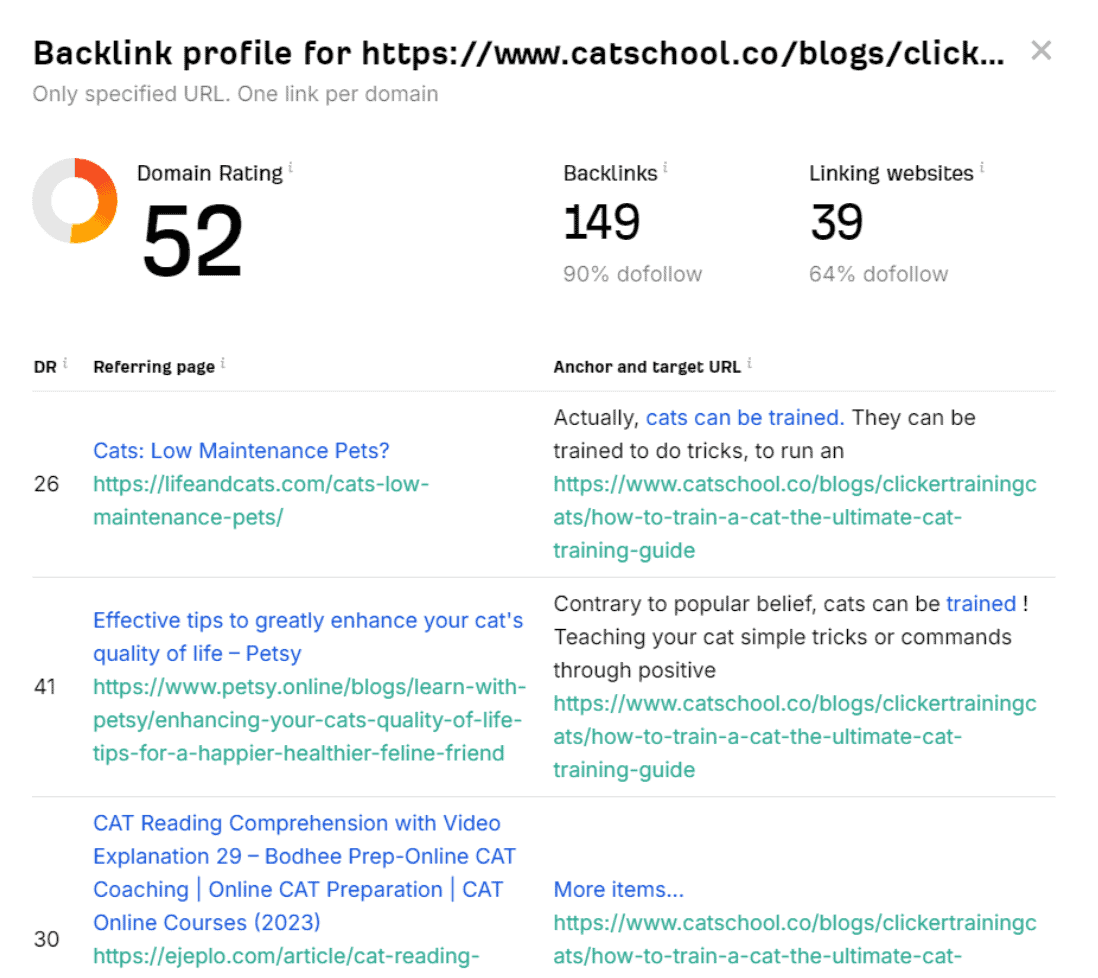
Backlinks gathered by the page
For example, one of the backlinks comes from a closely related blog post on Life and Cats, where the topic was “Cats: Low Maintenance Pets?”
Note that an editorial link has to be unsolicited — you neither request, trade, nor pay for it. Additionally, it’s embedded inside the content, like here:
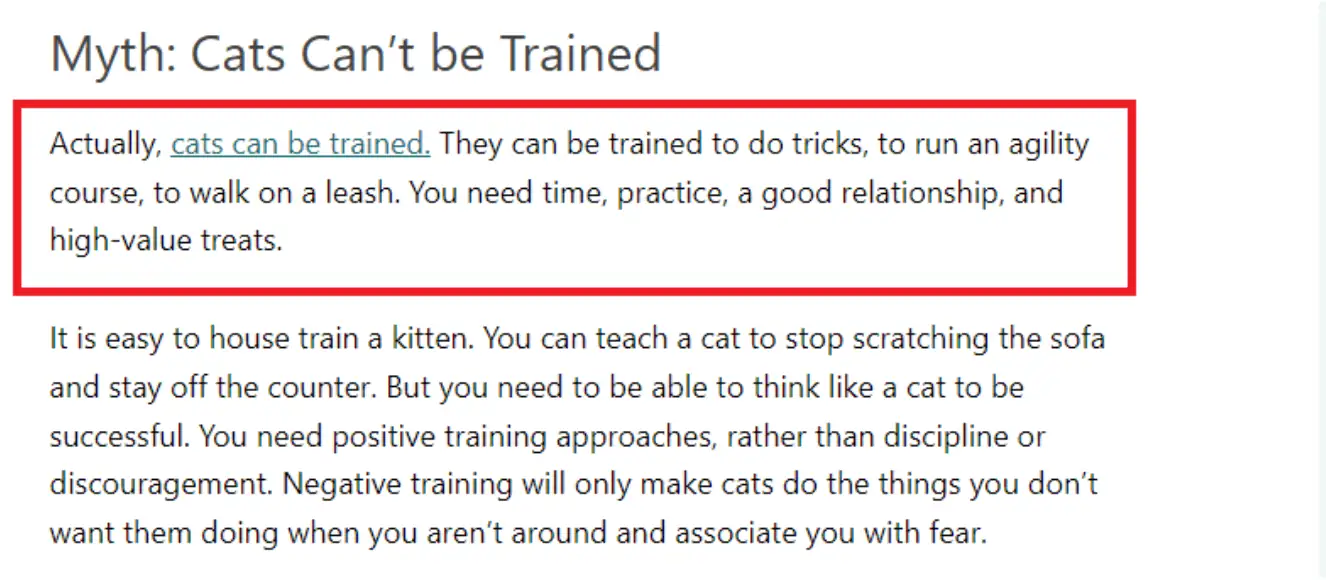
Source: Cats: Low Maintenance Pets?
High-quality editorial links are dofollow, which means they pass link equity. The anchor text optimizes the target article for a particular keyword and topic. Quality editorial links also come from a domain with a good Domain Rating or Authority score, indicating that it’s well-trusted by Google.
In our example, Life and Cats has used the anchor text, “cats can be trained,” providing signals to Google that the linked article has content that proves their claim. The website has a domain rating of 26, according to Ahrefs, which is not the best but still above the recommended minimum of 20+.
Getting editorial backlinks is one of the two primary ways of generating backlinks. Here’s how they compare to acquired links, the second type of backlinking:
- Acquired links: These are the links you can generate through manual outreach activities like directory links, article distribution, and fixing broken links. They are more common than editorial links because they are way easier to get. Some SEO experts attribute their popularity to the fact that they’re easier to define and explain to clients, which makes them an easier sale.
- Editorial links: Comparatively, editorial links are more challenging to earn. To acquire them, you must create good content. SEO experts always consider them the holy grail of backlinks. And reasonably so — a handful of editorial links from the best online publications within your niche can help you achieve your SEO goals faster than a ton of low-quality links from random, unestablished sites.
The Main Benefits of Editorial Links in SEO
Editorial links have the obvious advantage of being cheaper to acquire and less hectic because there is little initiative on your part. However, the main benefits of editorial links also include a positive impact on rankings, traffic growth, increased credibility, efficient budget use, and adaptability.
Higher SEO Rankings
Search engines have only come so far in determining if a piece of information is truthful, accurate, and expert-written. Editorial links directly endorse your content’s quality, elevating your SERP positions.
But don’t merely engage in paid linking with any site to boost the number of editorial links. Modern-day SEO algorithms prioritize link quality over quantity. Consequently, a few high-quality links from authoritative websites with higher ratings are more likely to elevate your SEO rankings than a bunch of low-quality links from spammy websites that may be misidentified as PBNs.
More Traffic
Editorial links placed on a popular piece of content with more organic traffic can lead to an incremental boost in your overall traffic due to referrals. Some seasoned niche websites and established publications may even have hundreds or thousands of daily visitors.
By linking to your web pages, they’re essentially endorsing you and directing their audience to check out your valuable content — enabling you to derive more traffic. For instance, when you earn an editorial link from Forbes, you’ll have a chance of reaching the publication’s over 150 million monthly visitors.
Credibility and Authority
Picture earning links from authority websites like CNN or The New York Times. Think about the instant credibility that accompanies such links.
Both visitors and search engines will associate your brand with being factual and informed, and an authority within your niche. For example, when local publications quote and link to your blog post, it’s indirectly telling its readers that your web page has quality content that’s relevant to the location.
Also, as more people visit your website from other sites, they familiarize themselves with your company and its offerings, enhancing your reputation, online presence, and brand building objectives. The more your target audience identifies and resonates with your brand online, the more authoritative your website becomes.
Budget-Friendliness
Traditional link building can be quite expensive. According to Ahrefs, big agencies charge approximately $240-$270 per acquired link. Even for large brands with well-funded marketing departments, this can be too expensive.
Fortunately, you don’t need to pay agencies to earn editorial links. All you have to do is create link-worthy content like a well-researched study with intriguing statistics that can generate media coverage on its own.
Adaptation to Changes in Search Engine Algorithms
People-first content is Google’s main focus, meaning that it prioritizes the needs and preferences of users over other factors. This means that quality content is not only about providing accurate and relevant information but also about engaging and satisfying the audience.
If you create valuable content, you will be able to preserve your rankings despite the frequent changes in search engine algorithms. Your own content will do the work for you and attract more editorial links. This focus on content merit makes editorial links important for building resilience against unexpected algorithm shifts.
Proven Strategies for Editorial Link Building
While editorial links result when other website owners link to you naturally, there are proven best practices that can increase your chances of earning them. Below are a few examples.
1. Analyzing Competitors’ High-Quality Links
You’ve heard the phrase that you should copy from the best. The same case applies to finding editorial link opportunities. You should start by identifying your online competitors and using SEO tools like Ahrefs or Semrush and then look into the high-quality links in their backlink profiles.
Here’s how to perform a comprehensive backlink profile analysis in three simple steps:
Step 1: Find your competitors
Browse your target keywords and note all the websites that also rank for them, especially those in the first SERP. Next, group them into two categories:
- Page-level competitors, including those competing with particular pages on your site;
- Domain-level competitors, including sites within your niche that target most of your keywords.
Step 2: Use backlink checkers to reverse-engineer the competitors’ backlinks
Next, paste URLs of identified competitors’ websites into SEO tools of your choice to discover the sites linking to them. Some backlink checkers can help you filter links based on their publication dates, link attributes like nofollow or dofollow, and their authority. Others will ask you to add your site so that they can exclude sites that are already linking to you.
Step 3: Identify competitors’ link building strategies
With this information, you can determine how your competitors went about creating content that boosted their link profile. If you identify a strategy that might be a great add-on to your current tactics for building editorial links, you can replicate it.
As an illustration, you may discover that your competitor published a study that ended up going viral. For instance, a 2014 study by Tecmark ended up receiving a lot of quotes from all the big publications as it tackled the issue of cellphone usage:
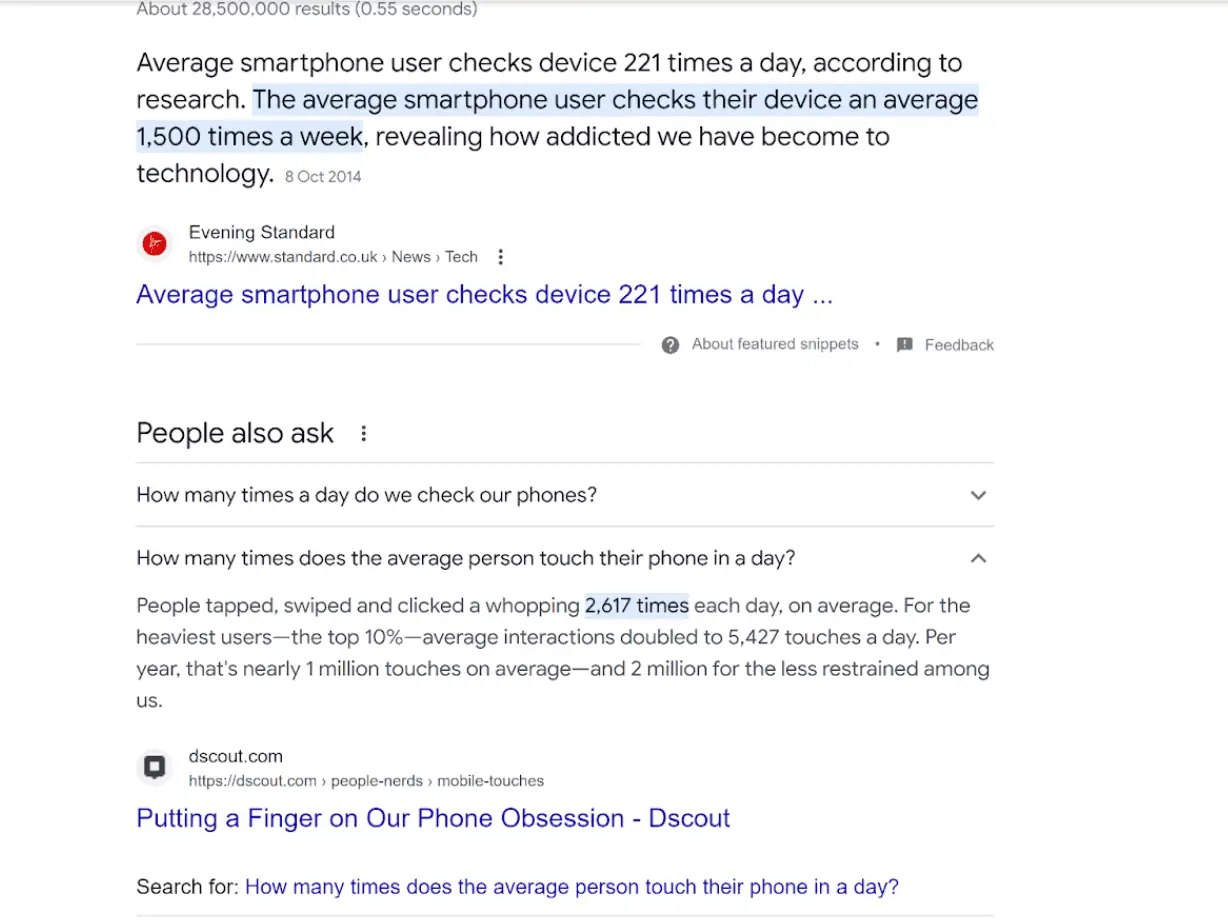
An example of different search results quoting the same study
After publishing high-quality content, you can also directly approach some of your competitors’ and persuade them to link to your sites. While links generated this way are not editorial links (because you requested them), this technique can help you generate a strong link profile faster.
2. Crafting Authoritative Content for Editorial Links SEO
SEO experts have advocated for this practice so many times that it’s become cliché. However, you can’t ignore the fact that you need to create evergreen content that fulfills the user’s quest for information if you want to attract organic traffic from Google.
Furthermore, the best way to attract links from high-ranking publications is to create interesting, relevant, factual, and high-quality content. First, doing so increases your chances of ranking for your niche’s keywords, making it easier for other editors to spot you. Second, and more importantly, it makes your content unique and establishes you as an authority.
To make your content link-worthy, conduct thorough audience research to understand your target market’s search intents, pain points, interests, and preferences. You can use survey and keyword research tools and online forums like Quora and Reddit.
Next, ensure your content covers these issues as extensively as possible. It also helps to review and update your past publications to ensure they have evergreen content. When you do so, inform editors with links to the old versions of these changes and suggest other linking opportunities.
For instance, this post from MIT SMR was one of the top articles in its year of publication: “The Surprising Impact of Meeting-Free Days.”
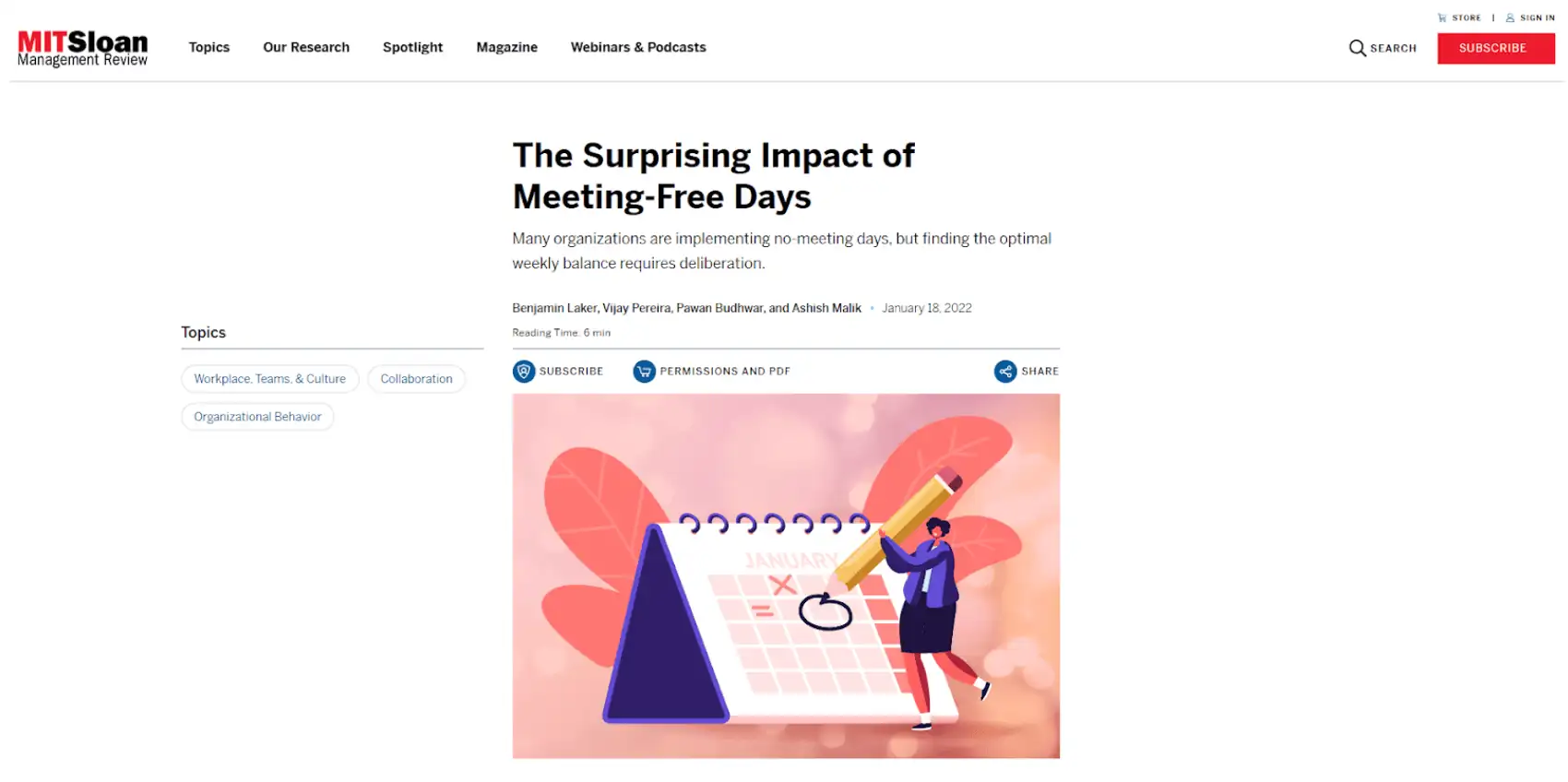
Source: The Surprising Impact of Meeting-Free Days
It performed well in terms of attracting links from high-DR sites such as Asana.com (90 DR) and Lifehacker.com (90).
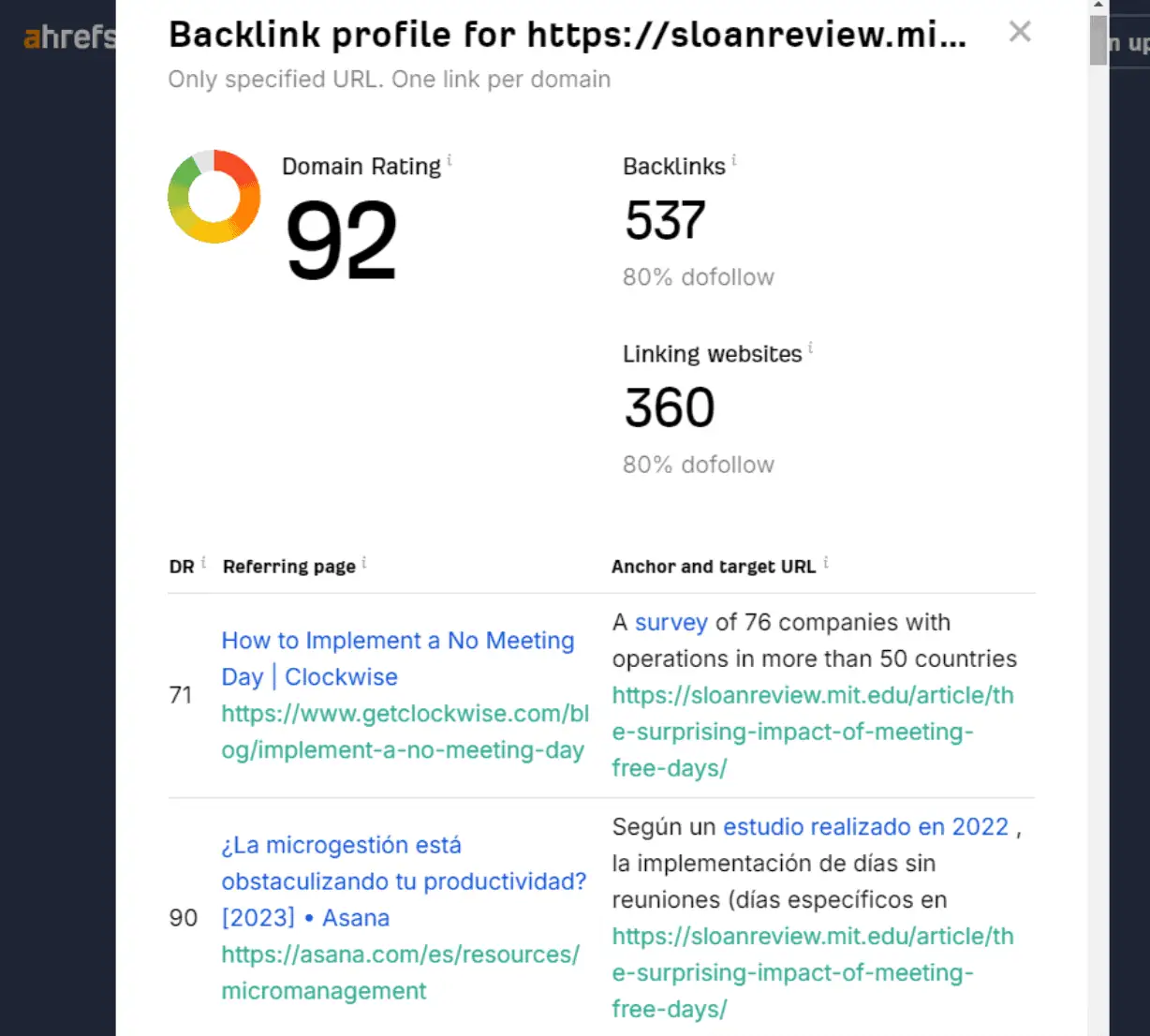
Backlink analysis for an article on MIT SMR
3. Dominating Your Niche with Editorial Links
Another quality link building strategy is to establish yourself as an authority within your niche. For example, there’s a reason tech writers are more likely to link to TechCrunch, IBM, or Gizmodo.
These websites have a long history of publishing high-quality, relevant, and link-worthy content, which makes them thought leaders in the tech field. That’s precisely what you should do in your niche.
To achieve this level of topical authority, you should continuously churn well-researched content on a particular topic that prioritizes depth over breadth. Provide more detail and discuss every possible perspective to offer audiences information that they may not find anywhere else. Also, you should avoid spreading yourself too thin by targeting many keywords at a time.
4. Engaging in Discussions
Don’t underestimate the value of public relations, press releases, media coverage, or online discussion forums like Reddit and Quora. Social media sites can help you introduce your content to other site owners and bait them into linking to your website. You can also build relationships with other experts this way.
Whenever there’s a hot debate on these forums, note the key issues, create content around them, and share. You can also respond to relevant requests or questions posted on these platforms.
If the content is well-written and contains backup statistics and data from reputable sources, it can position you as an expert in your niche, build relationships, and motivate others to link to it.
5. Utilizing Infographics in Editorial Link Building
Infographics are effective link magnets that can help you attract editorial backlinks for the simple reason of being eye-catching and attractive. For the best result, ensure the infographic is as informational as it is visually stunning. At the same time, keep it simple and easy to interpret.
If you create great infographics, it’s natural that some people will want to copy and embed them on their websites instead of linking to them. This may not have any SEO benefits — so, make sure you’re engaging in brand building by tagging the image with your site’s URL.
While embedded infographics may not generate more backlinks, a well-designed, informational one can make your web pages irresistible to link. They can also make readers interested in visiting your site and learning more.
Editorial Links Examples
Let’s go over two more examples of websites that have received editorial links from authoritative websites.
Example 1: In the following article on “Major Predictions For Marketing in 2023,” the Forbes contributor has linked to research conducted by ICAEW to bolster the article’s claims:
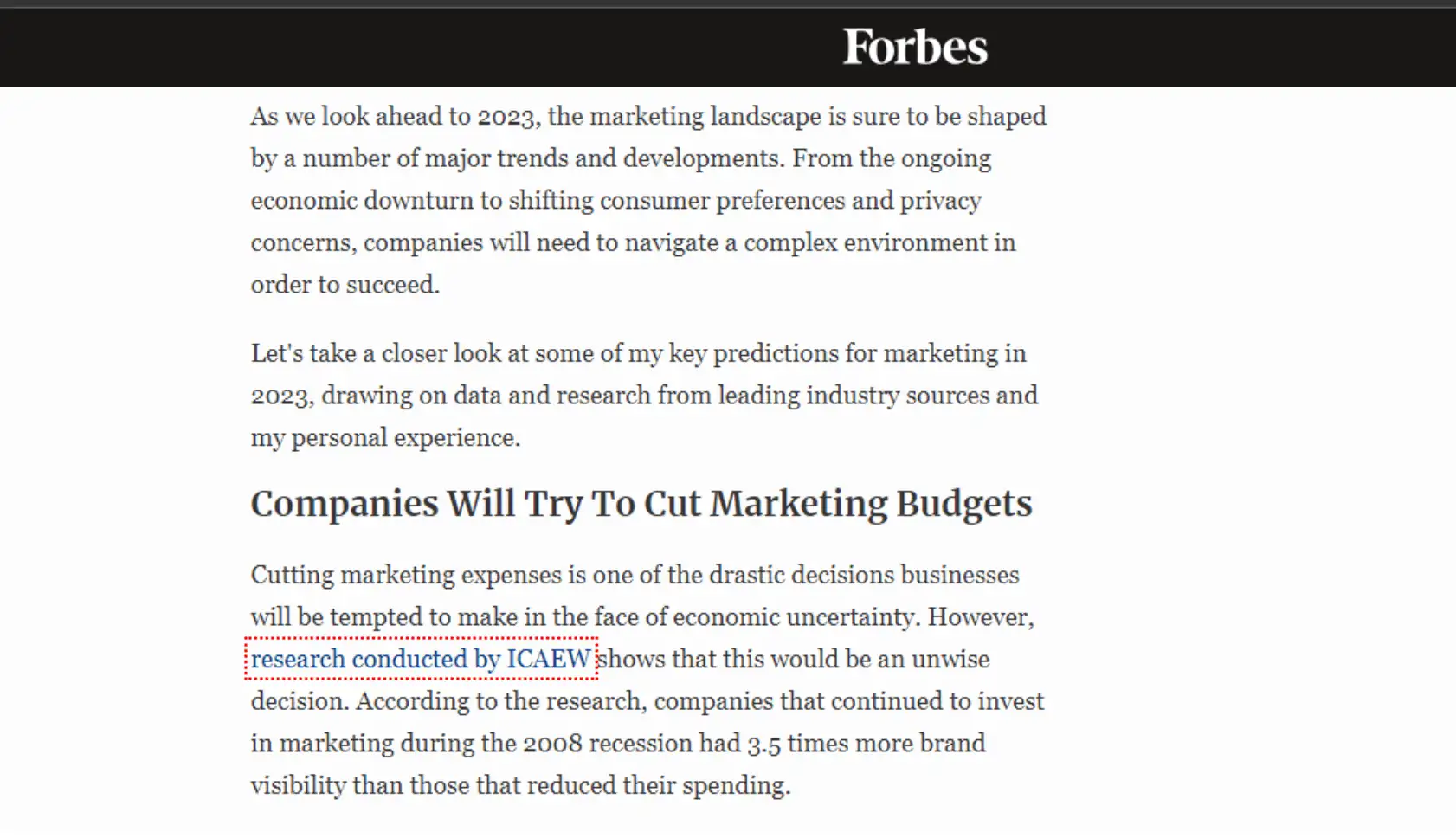
Source: Major Predictions For Marketing in 2023
But note that the link here is nofollow, meaning that it doesn’t pass any authority. That said, other site owners will likely discover the research and link to it naturally. ICAEW will become better known for providing marketing insights.
Example 2: In the following article published on TechCrunch about ShareChat facing a large valuation cut in new funding, the writer has linked to EnTrackr another publication that covers startups in the region:

Source: ShareChat faces large valuation cut in new funding
The writer included the link to back up the figures they were providing.
Monitoring and Analyzing Your Editorial Backlink Performance
Getting more editorial links is not a one-time project. As a site owner, you’ll need to continuously monitor, audit, analyze, and adjust your tactics. A dynamic link building approach will ensure your strategies are up-to-date and responsive to the ever-changing SEO algorithms.
So, how do you analyze the performance of your editorial links to get the most SEO value? Below are a few metrics to look out for:
1. Number of Editorial Backlinks
Of course, the most obvious indicator of a successful editorial link building campaign is an increase in the number of outbound links to your website. You can use backlink checkers to review your backlink statistics. Some backlink monitoring tools also give users real-time visibility into percentage changes in editorial and other links, their sources, whether there are broken links, and the DR of each domain.
2. Number of Referring Domains
Checking if your inbound links have increased or decreased is not enough, however. You should also confirm where they’re coming from.
The more people link to you, the more effective your link building strategy is. Search engines also interpret link diversity as proof of credibility.
On the contrary, receiving tons of backlinks from a handful of sources can be suspicious. It can show search engines that you bought these links instead of earning them through your content’s merit, harming your reputation and reducing your chances of achieving higher Google search rankings.
3. Anchor Text Distribution and Relevance
Another crucial factor to consider is the distribution of linking anchor texts. Like with referring domains, the overuse of similar or closely related anchor text can position you as a backlink buyer. The assumption is that if you earned the links naturally from different unrelated websites, there are very slim chances that they’ll use the same anchor texts.
Besides distribution, you should also review the anchor texts’ relevance. For example, if your content talks about “best tuna fishing spots in Chicagoland,” it might not be sensible if it gets an inbound link from an article talking about “the main benefits of email marketing.” Such irregularities can prompt Google to penalize you.
4. Link Acquisition Rate
Unlike acquired links, natural links take time to build. Sometimes, it might take several weeks or months before you start recording any substantial results. Therefore, the gains should be gradual, consistent, and proportional to your efforts — a sudden increase should be a red flag.
Similarly, because of the strategy’s focus on good content quality, you’re likely to enjoy the benefits longer. Thus, sudden drops in the number of backlinks should also be a red flag.
5. Link Type
Editorial links can be either nofollow (signaling search engines not to consider your content for ranking) or dofollow (telling search engines to crawl the link and pass SEO value). An effective link building strategy should yield more do-follow links.
6. Relevance of Linking Sites
While there’s no harm in getting editorial links outside your niche, the most valuable links come from the best editorial websites within your industry. For example, if your site focuses on finance, it’s more valuable if you get links from finance-related websites.
In any case, your goal is to get a nod of approval from stakeholders within your industry. When you receive editorial links from outside your niche, at least ensure the content is relevant.
Conclusion
Editorial link building is a crucial aspect of SEO that can boost your online presence and reputation. By creating content that attracts natural links from other websites, you can increase your authority, traffic, and rankings. Unlike paid links, editorial links don’t require any payment or exchange, which makes them more cost-effective and trustworthy.
Although it’s possible to buy editorial links, this is a little more involved than simply exchanging money for backlinks. You can buy premium editorial links by creating high-quality guest posts and press releases that get published on quality websites through careful outreach.
However, editorial link building is not a one-time effort. You need to constantly monitor the changes in the SEO landscape and adapt your strategies accordingly to reap the benefits of editorial links. This way, you can ensure that your content remains fresh, engaging, and authoritative and that your editorial links continue to deliver optimal results.






